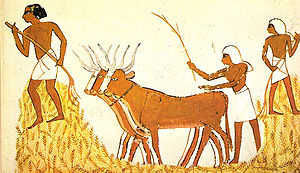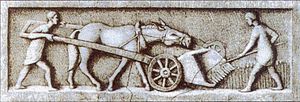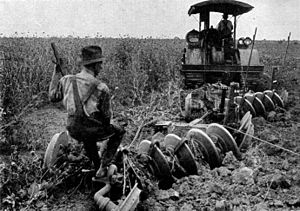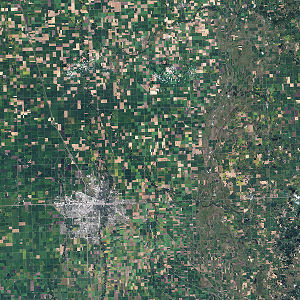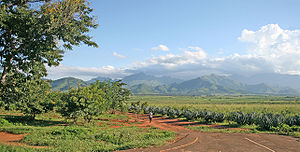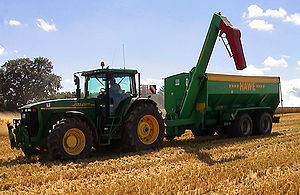Agriculture
Search for "Agriculture" on Wikipedia • Wikimedia Commons • Wiktionary • Wikiquote • Wikibooks • Mediawiki • Wikia • Wikitravel • DuckDuckGo • WorldCat Amazon • Recent NY Times.
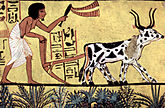 |
| Agriculture |
|---|
| General |
| History |
| Types |
| Categories |
Agriculture also called farming or husbandry is the cultivation of animals, plants, fungi, and other life forms for food, fiber, biofuel and other products used to sustain life.[1] Agriculture was the key development in the rise of sedentary human civilization, whereby farming of domesticated species created food surpluses that nurtured the development of civilization. The study of agriculture is known as agricultural science. Agriculture generally speaking refers to human activities, although it is also observed in certain species of ant and termite.[2][3]
The history of agriculture dates back thousands of years, and its development has been driven and defined by greatly different climates, cultures, and technologies. However, all farming generally relies on techniques to expand and maintain the lands suitable for raising domesticated species. For plants, this usually requires some form of irrigation, although there are methods of dryland farming; pastoral herding on rangeland is still the most common means of raising livestock. In the developed world, industrial agriculture based on large-scale monoculture has become the dominant system of modern farming, although there is growing support for sustainable agriculture (e.g. permaculture or organic agriculture).
Modern agronomy, plant breeding, pesticides and fertilizers, and technological improvements have sharply increased yields from cultivation, but at the same time have caused widespread ecological damage and negative human health effects.[4] Selective breeding and modern practices in animal husbandry such as intensive pig farming have similarly increased the output of meat, but have raised concerns about animal cruelty and the health effects of the antibiotics, growth hormones, and other chemicals commonly used in industrial meat production.[5]
The major agricultural products can be broadly grouped into foods, fibers, fuels, and raw materials. In the 21st century, plants have been used to grow biofuels, biopharmaceuticals, bioplastics,[6] and pharmaceuticals.[7] Specific foods include cereals, vegetables, fruits, and meat. Fibers include cotton, wool, hemp, silk and flax. Raw materials include lumber and bamboo. Other useful materials are produced by plants, such as resins. Biofuels include methane from biomass, ethanol, and biodiesel. Cut flowers, nursery plants, tropical fish and birds for the pet trade are some of the ornamental products. Regarding food production, the World Bank targets agricultural food production and water management as an increasingly global issue that is fostering an important and growing debate.[8]
In one third of the world's workers were employed in agriculture. The services sector has overtaken agriculture as the economic sector employing the most people worldwide.[9] Despite the size of its workforce, agricultural production accounts for less than five percent of the gross world product (an aggregate of all gross domestic products).
Contents
- 1 Etymology
- 2 Overview
- 3 History
- 4 Crop production systems
- 5 Livestock production systems
- 6 Production practices
- 7 Processing, distribution, and marketing
- 8 Crop alteration and biotechnology
- 9 Modern agriculture
- 10 Food safety, labeling and regulation
- 11 Environmental impact
- 12 International economics and market reports
- 13 List of countries by agricultural output
- 14 Energy and agriculture
- 15 Policy
- 16 See also
- 17 References
- 18 Bibliography
- 19 External links
Etymology
The word agriculture is the English adaptation of Latin agricultūra, from ager, "a field",[10] and cultūra, "cultivation" in the strict sense of "tillage of the soil".[11] Thus, a literal reading of the word yields "tillage of a field / of fields".
Overview
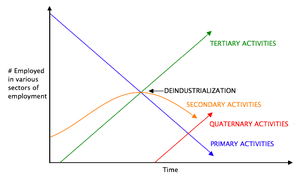
Agriculture has played a key role in the development of human civilization. Until the Industrial Revolution, the vast majority of the human population labored in agriculture. The type of agriculture they developed was typically subsistence agriculture in which farmers raised most of their crops for consumption on farm, and there was only a small portion left over for the payment of taxes, dues, or trade. In subsistence agriculture cropping decisions are made with an eye to what the family needs for food, and to make clothing, and not the world marketplace. Development of agricultural techniques has steadily increased agricultural productivity, and the widespread diffusion of these techniques during a time period is often called an agricultural revolution. A remarkable shift in agricultural practices has occurred over the past century in response to new technologies, and the development of world markets. This also led to technological improvements in agricultural techniques, such as the Haber-Bosch method for synthesizing ammonium nitrate which made the traditional practice of recycling nutrients with crop rotation and animal manure less necessary.
Synthetic nitrogen, along with mined rock phosphate, pesticides and mechanization, have greatly increased crop yields in the early 20th century. Increased supply of grains has led to cheaper livestock as well. Further, global yield increases were experienced later in the 20th century when high-yield varieties of common staple grains such as rice, wheat, and corn (maize) were introduced as a part of the Green Revolution. The Green Revolution exported the technologies (including pesticides and synthetic nitrogen) of the developed world to the developing world. Thomas Malthus famously predicted that the Earth would not be able to support its growing population, but technologies such as the Green Revolution have allowed the world to produce a surplus of food.[12]
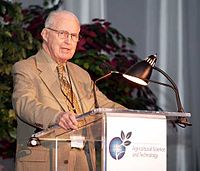
Many governments have subsidized agriculture for a variety of political and economic reasons. These agricultural subsidies are often linked to the production of certain commodities such as wheat, corn (maize), rice, soybeans, and milk. These subsidies, especially when instituted by developed countries have been noted as protectionist, inefficient, and environmentally damaging.[13]
In the past century agriculture has been characterized by enhanced productivity, the use of synthetic fertilizers and pesticides, selective breeding, mechanization, water contamination, and farm subsidies. Proponents of organic farming such as Sir Albert Howard argued in the early 20th century that the overuse of pesticides and synthetic fertilizers damages the long-term fertility of the soil. While this feeling lay dormant for decades, as environmental awareness has increased in the 21st century there has been a movement towards sustainable agriculture by some farmers, consumers, and policymakers.
In recent years there has been a backlash against perceived external environmental effects of mainstream agriculture, particularly regarding water pollution,[14] resulting in the organic movement. One of the major forces behind this movement has been the European Union, which first certified organic food in and began reform of its Common Agricultural Policy (CAP) in to phase out commodity-linked farm subsidies,[15] also known as decoupling. The growth of organic farming has renewed research in alternative technologies such as integrated pest management and selective breeding. Recent mainstream technological developments include genetically modified food.
In late several factors pushed up the price of grains consumed by humans as well as used to feed poultry and dairy cows and other cattle, causing higher prices of wheat (up 58%), soybean (up 32%), and maize (up 11%) over the year.[16][17] Food riots took place in several countries across the world.[18][19][20] Contributing factors included drought in Australia and elsewhere, increasing demand for grain-fed animal products from the growing middle classes of countries such as China and India, diversion of foodgrain to biofuel production and trade restrictions imposed by several countries.
An epidemic of stem rust on wheat caused by race Ug99 is currently spreading across Africa and into Asia and is causing major concern.[21][22][23] Approximately 40% of the world's agricultural land is seriously degraded.[24] In Africa, if current trends of soil degradation continue, the continent might be able to feed just 25% of its population by according to UNU's Ghana-based Institute for Natural Resources in Africa.[25]
History
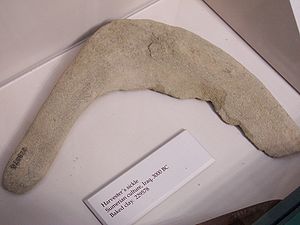
Agricultural practices such as irrigation, crop rotation, fertilizers, and pesticides were developed long ago, but have made great strides in the past century. The history of agriculture has played a major role in human history, as agricultural progress has been a crucial factor in worldwide socio-economic change. Division of labor in agricultural societies made commonplace specializations rarely seen in hunter-gatherer cultures. So, too, are arts such as epic literature and monumental architecture, as well as codified legal systems. When farmers became capable of producing food beyond the needs of their own families, others in their society were freed to devote themselves to projects other than food acquisition. Historians and anthropologists have long argued that the development of agriculture made civilization possible. The total world population probably never exceeded 15 million inhabitants before the invention of agriculture.[26]
Prehistoric origins
Forest gardening, a plant-based food production system, is thought to be the world's oldest known form of agriculture.[27] Forest gardens originated in prehistoric times along jungle-clad river banks and in the wet foothills of monsoon regions. In the gradual process of a family improving their immediate environment, useful tree and vine species were identified, protected and improved whilst undesirable species were eliminated. Eventually superior foreign species were selected and incorporated into the family's garden.[28]
Ancient history
The Fertile Crescent of Western Asia, Egypt, and India were sites of the earliest planned sowing and harvesting of plants that had previously been gathered in the wild. Independent development of agriculture occurred in northern and southern China, Africa's Sahel, New Guinea and several regions of the Americas.[29] The eight so-called Neolithic founder crops of agriculture appear: first emmer wheat and einkorn wheat, then hulled barley, peas, lentils, bitter vetch, chick peas and flax.
By 7000 BC, small-scale agriculture reached Egypt. From at least 7000 BC the Indian subcontinent saw farming of wheat and barley, as attested by archaeological excavation at Mehrgarh in Balochistan in what is present day Pakistan. By 6000 BC, mid-scale farming was entrenched on the banks of the Nile. This, as irrigation had not yet matured sufficiently. About this time, agriculture was developed independently in the Far East, with rice, rather than wheat, as the primary crop. Chinese and Indonesian farmers went on to domesticate taro and beans including mung, soy and azuki. To complement these new sources of carbohydrates, highly organized net fishing of rivers, lakes and ocean shores in these areas brought in great volumes of essential protein. Collectively, these new methods of farming and fishing inaugurated a human population boom that dwarfed all previous expansions and continues today.
By 5000 BC, the Sumerians had developed core agricultural techniques including large-scale intensive cultivation of land, monocropping, organized irrigation, and the use of a specialized labor force, particularly along the waterway now known as the Shatt al-Arab, from its Persian Gulf delta to the confluence of the Tigris and Euphrates. Domestication of wild aurochs and mouflon into cattle and sheep, respectively, ushered in the large-scale use of animals for food/fiber and as beasts of burden. The shepherd joined the farmer as an essential provider for sedentary and seminomadic societies. Maize, manioc, and arrowroot were first domesticated in the Americas as far back as 5200 BC.[30]
The potato, tomato, pepper, squash, several varieties of bean, tobacco, and several other plants were also developed in the Americas, as was extensive terracing of steep hillsides in much of Andean South America. The Greeks and Romans built on techniques pioneered by the Sumerians, but made few fundamentally new advances. Southern Greeks struggled with very poor soils, yet managed to become a dominant society for years. The Romans were noted for an emphasis on the cultivation of crops for trade.
In the same region, a parallel agricultural revolution occurred, resulting in some of the most important crops grown today. In Mesoamerica wild teosinte was transformed through human selection into the ancestor of modern maize, more than 6000 years ago. It gradually spread across North America and was the major crop of Native Americans at the time of European exploration.[31] Other Mesoamerican crops include hundreds of varieties of squash and beans. Cocoa was also a major crop in domesticated Mexico and Central America. The turkey, one of the most important meat birds, was probably domesticated in Mexico or the U.S. Southwest. In the Andes region of South America the major domesticated crop was potatoes, domesticated perhaps 5000 years ago. Large varieties of beans were domesticated, in South America, as well as animals, including llamas, alpacas, and guinea pigs. Coca, still a major crop, was also domesticated in the Andes.
A minor center of domestication, the indigenous people of the Eastern U.S. appear to have domesticated numerous crops. Sunflowers, tobacco,[32] varieties of squash and Chenopodium, as well as crops no longer grown, including marshelder and little barley were domesticated.[33][34] Other wild foods may have undergone some selective cultivation, including wild rice and maple sugar. The most common varieties of strawberry were domesticated from Eastern North America.[35]
By 3500 BC, the simplest form of the plough was developed, called the ard.[36] Before this period, simple digging sticks or hoes were used. These tools would have also been easier to transport, which was a benefit as people only stayed until the soil's nutrients were depleted. However, through excavations in Mexico it has been found that the continuous cultivating of smaller pieces of land would also have been a sustaining practice. Additional research in central Europe later revealed that agriculture was indeed practiced at this method. For this method, ards were thus much more efficient than digging sticks.[37]
Middle Ages
- The section could be expanded
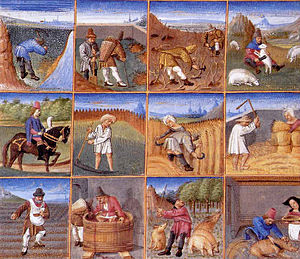
The Middle Ages saw significant improvements in the agricultural techniques and technology. There was a steady clearing of woodlands and draining of wetlands for the increase of cropland throughout the period until about the year 1300. Tools such as axes, adzes, and bill-hooks were improved, but most significant was the gradual evolution of the scratch plough from the classical Mediterranean world into the mouldboard plough capable of turning over the heavy soils of northern Europe. The period saw a general move from a two field crop rotation to a three field crop rotation in which one field of three was left fallow every year. Also, there was a general change from small patchworks of fields to one large open field divided into strips owned by various members of a community. The use of watermills was common in the Middle Ages. There was tremendous increase in windmills from the 12th to the 13th century; some tens of thousands were built.
Crops where wheat, rye, barley, and oats. Peas, beans, and vetches became common from the 13th century onward as a fodder crop for animals and also for their nitrogen-fixation fertilizing properties. Crop yields peaked in the 13th century, and according to Bruce Campbell and Mark Overton stayed more or less steady until the 18th century.[38]
Though the limitations of Medieval farming were once thought to have provided a ceiling for the population growth in the Middle Ages, recent studies by Campbell[39] and David Stone[40] have shown that the technology of Medieval agriculture was always sufficient for the needs of the people under normal circumstances, and that it was only during exceptionally harsh times, such as the terrible weather of 1315–17, that the needs of the population could not be met.[41]
Modern era
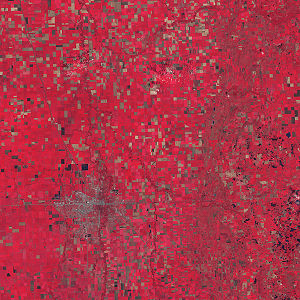
After 1492, a global exchange of previously local crops and livestock breeds occurred. Key crops involved in this exchange included the tomato, maize, potato, manioc, cocoa bean and tobacco going from the New World to the Old, and several varieties of wheat, spices, coffee, and sugar cane going from the Old World to the New. The most important animal exportation from the Old World to the New were those of the horse and dog (dogs were already present in the pre-Columbian Americas but not in the numbers and breeds suited to farm work). Although not usually food animals, the horse (including donkeys and ponies) and dog quickly filled essential production roles on western-hemisphere farms.
The potato became an important staple crop in northern Europe.[42] Since being introduced by Portuguese in the 16th century,[43] maize and manioc have replaced traditional African crops as the continent's most important staple food crops.[44]
By the early 19th century, agricultural techniques, implements, seed stocks and cultivar had so improved that yield per land unit was many times that seen in the Middle Ages. Although there is a vast and interesting history of crop cultivation before the dawn of the 20th century, there is little question that the work of Charles Darwin and Gregor Mendel created the scientific foundation for plant breeding that led to its explosive impact over the past 150 years.[45]
With the rapid rise of mechanization in the late 19th century and the 20th century, particularly in the form of the tractor, farming tasks could be done with a speed and on a scale previously impossible. These advances have led to efficiencies enabling certain modern farms in the United States, Argentina, Israel, the United Kingdom Germany, and a few other nations to output volumes of high-quality produce per land unit at what may be the practical limit.
The Haber-Bosch method for synthesizing ammonium nitrate represented a major breakthrough and allowed crop yields to overcome previous constraints. In the past century agriculture has been characterized by enhanced productivity, the substitution of synthetic fertilizers and pesticides for labor, water pollution, and farm subsidies. In recent years there has been a backlash against the external environmental effects of conventional agriculture, resulting in the organic movement.
The cereals rice, corn, and wheat provide 60% of human food supply.[46] Between 1700 and 1980, "the total area of cultivated land worldwide increased 466%" and yields increased dramatically, particularly because of selectively bred high-yielding varieties, fertilizers, pesticides, irrigation, and machinery.[46] For example, irrigation increased corn yields in eastern Colorado by 400 to 500% from to 1997.[46]
However, concerns have been raised over the sustainability of intensive agriculture. Intensive agriculture has become associated with decreased soil quality in India and Asia, and there has been increased concern over the effects of fertilizers and pesticides on the environment, particularly as population increases and food demand expands. The monocultures typically used in intensive agriculture increase the number of pests, which are controlled through pesticides. Integrated pest management (IPM), which "has been promoted for decades and has had some notable successes" has not significantly affected the use of pesticides because policies encourage the use of pesticides and IPM is knowledge-intensive.[46]
Although the "Green Revolution" significantly increased rice yields in Asia, yield increases have not occurred in the past 15–20 years.[47] The genetic "yield potential" has increased for wheat, but the yield potential for rice has not increased since 1966, and the yield potential for maize has "barely increased in 35 years".[47] It takes a decade or two for herbicide-resistant weeds to emerge, and insects become resistant to insecticides within about a decade.[47] Crop rotation helps to prevent resistances.[47]
Agricultural exploration expeditions, since the late 19th century, have been mounted to find new species and new agricultural practices in different areas of the world. Two early examples of expeditions include Frank N. Meyer's fruit- and nut-collecting trip to China and Japan from 1916–1918[48] and the Dorsett-Morse Oriental Agricultural Exploration Expedition to China, Japan, and Korea from 1929–1931 to collect soybean germplasm to support the rise in soybean agriculture in the United States.[49]
In the agricultural output of China was the largest in the world, followed by the European Union, India and the United States, according to the International Monetary Fund (see below). Economists measure the total factor productivity of agriculture and by this measure agriculture in the United States is roughly 2.6 times more productive than it was in 1948.[50]
Six countries – the US, Canada, France, Australia, Argentina and Thailand – supply 90% of grain exports.[51] Water deficits, which are already spurring heavy grain imports in numerous middle-sized countries, including Algeria, Iran, Egypt, and Mexico,[52] may soon do the same in larger countries, such as China or India.[53]
Crop production systems
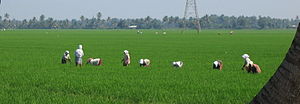
Cropping systems vary among farms depending on the available resources and constraints; geography and climate of the farm; government policy; economic, social and political pressures; and the philosophy and culture of the farmer.[54][55] Shifting cultivation (or slash and burn) is a system in which forests are burnt, releasing nutrients to support cultivation of annual and then perennial crops for a period of several years.[56]
Then the plot is left fallow to regrow forest, and the farmer moves to a new plot, returning after many more years (10–20). This fallow period is shortened if population density grows, requiring the input of nutrients (fertilizer or manure) and some manual pest control. Annual cultivation is the next phase of intensity in which there is no fallow period. This requires even greater nutrient and pest control inputs.
Further industrialization lead to the use of monocultures, when one cultivar is planted on a large acreage. Because of the low biodiversity, nutrient use is uniform and pests tend to build up, necessitating the greater use of pesticides and fertilizers.[55] Multiple cropping, in which several crops are grown sequentially in one year, and intercropping, when several crops are grown at the same time are other kinds of annual cropping systems known as polycultures.[56]
In tropical environments, all of these cropping systems are practiced. In subtropical and arid environments, the timing and extent of agriculture may be limited by rainfall, either not allowing multiple annual crops in a year, or requiring irrigation. In all of these environments perennial crops are grown (coffee, chocolate) and systems are practiced such as agroforestry. In temperate environments, where ecosystems were predominantly grassland or prairie, highly productive annual cropping is the dominant farming system.[56]
The last century has seen the intensification, concentration and specialization of agriculture, relying upon new technologies of agricultural chemicals (fertilizers and pesticides), mechanization, and plant breeding (hybrids and GMO's). In the past few decades, a move towards sustainability in agriculture has also developed, integrating ideas of socio-economic justice and conservation of resources and the environment within a farming system.[57][58] This has led to the development of many responses to the conventional agriculture approach, including organic agriculture, urban agriculture, community supported agriculture, ecological or biological agriculture, integrated farming and holistic management, as well as an increased trend towards agricultural diversification.
Crop statistics
Important categories of crops include grains and pseudograins, pulses (legumes), forage, and fruits and vegetables. Specific crops are cultivated in distinct growing regions throughout the world. In millions of metric tons, based on FAO estimate.
| Top agricultural products, by crop types (million tonnes) data |
|
|---|---|
| Cereals | 2,263 |
| Vegetables and melons | 866 |
| Roots and Tubers | 715 |
| Milk | 619 |
| Fruit | 503 |
| Meat | 259 |
| Oilcrops | 133 |
| Fish (estimate) | 130 |
| Eggs | 63 |
| Pulses | 60 |
| Vegetable Fiber | 30 |
| Source: Food and Agriculture Organization (FAO)[59] |
|
| Top agricultural products, by individual crops (million tonnes) data |
|
|---|---|
| Sugar Cane | 1,324 |
| Maize | 721 |
| Wheat | 627 |
| Rice | 605 |
| Potatoes | 328 |
| Sugar Beet | 249 |
| Soybean | 204 |
| Oil Palm Fruit | 162 |
| Barley | 154 |
| Tomato | 120 |
| Source: Food and Agriculture Organization (FAO)[59] |
|
Livestock production systems
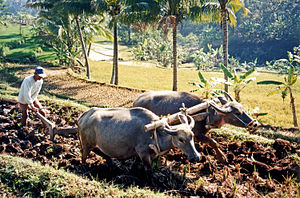
Animals, including horses, mules, oxen, camels, llamas, alpacas, and dogs, are often used to help cultivate fields, harvest crops, wrangle other animals, and transport farm products to buyers. Animal husbandry not only refers to the breeding and raising of animals for meat or to harvest animal products (like milk, eggs, or wool) on a continual basis, but also to the breeding and care of species for work and companionship. Livestock production systems can be defined based on feed source, as grassland – based, mixed, and landless.[60]
Grassland based livestock production relies upon plant material such as shrubland, rangeland, and pastures for feeding ruminant animals. Outside nutrient inputs may be used, however manure is returned directly to the grassland as a major nutrient source. This system is particularly important in areas where crop production is not feasible because of climate or soil, representing 30–40 million pastoralists.[56] Mixed production systems use grassland, fodder crops and grain feed crops as feed for ruminant and monogastic (one stomach; mainly chickens and pigs) livestock. Manure is typically recycled in mixed systems as a fertilizer for crops. Approximately 68% of all agricultural land is permanent pastures used in the production of livestock.[61]
Landless systems rely upon feed from outside the farm, representing the de-linking of crop and livestock production found more prevalently in OECD member countries. In the U.S., 70% of the grain grown is fed to animals on feedlots.[56] Synthetic fertilizers are more heavily relied upon for crop production and manure utilization becomes a challenge as well as a source for pollution.
Production practices
Tillage is the practice of plowing soil to prepare for planting or for nutrient incorporation or for pest control. Tillage varies in intensity from conventional to no-till. It may improve productivity by warming the soil, incorporating fertilizer and controlling weeds, but also renders soil more prone to erosion, triggers the decomposition of organic matter releasing CO2, and reduces the abundance and diversity of soil organisms.[62][63]
Pest control includes the management of weeds, insects/mites, and diseases. Chemical (pesticides), biological (biocontrol), mechanical (tillage), and cultural practices are used. Cultural practices include crop rotation, culling, cover crops, intercropping, composting, avoidance, and resistance. Integrated pest management attempts to use all of these methods to keep pest populations below the number which would cause economic loss, and recommends pesticides as a last resort.[64]
Nutrient management includes both the source of nutrient inputs for crop and livestock production, and the method of utilization of manure produced by livestock. Nutrient inputs can be chemical inorganic fertilizers, manure, green manure, compost and mined minerals.[65] Crop nutrient use may also be managed using cultural techniques such as crop rotation or a fallow period.[66][67] Manure is used either by holding livestock where the feed crop is growing, such as in managed intensive rotational grazing, or by spreading either dry or liquid formulations of manure on cropland or pastures.
Water management is where rainfall is insufficient or variable, which occurs to some degree in most regions of the world.[56] Some farmers use irrigation to supplement rainfall. In other areas such as the Great Plains in the U.S. and Canada, farmers use a fallow year to conserve soil moisture to use for growing a crop in the following year.[68] Agriculture represents 70% of freshwater use worldwide.[69]
Processing, distribution, and marketing
In the United States, food costs attributed to processing, distribution, and marketing have risen while the costs attributed to farming have declined. This is related to the greater efficiency of farming, combined with the increased level of value addition (e.g. more highly processed products) provided by the supply chain. From to the farm share was around 40%, but by it had declined to 30% and by 1998, 22.2%. Market concentration has increased in the sector as well, with the top 20 food manufacturers accounting for half the food-processing value in 1995, over double that produced in 1954. As of the top six US supermarket groups had 50% of sales compared to 32% in 1992. Although the total effect of the increased market concentration is likely increased efficiency, the changes redistribute economic surplus from producers (farmers) and consumers, and may have negative implications for rural communities.[70]
Crop alteration and biotechnology
Crop alteration has been practiced by humankind for thousands of years, since the beginning of civilization. Altering crops through breeding practices changes the genetic make-up of a plant to develop crops with more beneficial characteristics for humans, for example, larger fruits or seeds, drought-tolerance, or resistance to pests. Significant advances in plant breeding ensued after the work of geneticist Gregor Mendel. His work on dominant and recessive alleles gave plant breeders a better understanding of genetics and brought great insights to the techniques utilized by plant breeders. Crop breeding includes techniques such as plant selection with desirable traits, self-pollination and cross-pollination, and molecular techniques that genetically modify the organism.[71]
Domestication of plants has, over the centuries increased yield, improved disease resistance and drought tolerance, eased harvest and improved the taste and nutritional value of crop plants. Careful selection and breeding have had enormous effects on the characteristics of crop plants. Plant selection and breeding in the 1920s and 1930s improved pasture (grasses and clover) in New Zealand. Extensive X-ray and ultraviolet induced mutagenesis efforts (i.e. primitive genetic engineering) during the 1950s produced the modern commercial varieties of grains such as wheat, corn (maize) and barley.[72][73]
The Green Revolution popularized the use of conventional hybridization to increase yield many folds by creating "high-yielding varieties". For example, average yields of corn (maize) in the USA have increased from around 2.5 tons per hectare (t/ha) (40 bushels per acre) in to about 9.4 t/ha (150 bushels per acre) in. Similarly, worldwide average wheat yields have increased from less than 1 t/ha in to more than 2.5 t/ha in 1990. South American average wheat yields are around 2 t/ha, African under 1 t/ha, Egypt and Arabia up to 3.5 to 4 t/ha with irrigation. In contrast, the average wheat yield in countries such as France is over 8 t/ha. Variations in yields are due mainly to variation in climate, genetics, and the level of intensive farming techniques (use of fertilizers, chemical pest control, growth control to avoid lodging).[74][75][76]
Genetic engineering
Genetically Modified Organisms (GMO) are organisms whose genetic material has been altered by genetic engineering techniques generally known as recombinant DNA technology. Genetic engineering has expanded the genes available to breeders to utilize in creating desired germlines for new crops. After mechanical tomato-harvesters were developed in the early 1960s, agricultural scientists genetically modified tomatoes to be more resistant to mechanical handling. More recently, genetic engineering is being employed in various parts of the world, to create crops with other beneficial traits. New research on woodland strawberry genome was found to be short and easy to manipulate. Researchers now have tools to improve strawberry flavors and aromas of cultivated strawberries as stated in a publication by Nature Genetics.
Herbicide-tolerant GMO crops
Roundup Ready seed has a herbicide resistant gene implanted into its genome that allows the plants to tolerate exposure to glyphosate. Roundup is a trade name for a glyphosate-based product, which is a systemic, nonselective herbicide used to kill weeds. Roundup Ready seeds allow the farmer to grow a crop that can be sprayed with glyphosate to control weeds without harming the resistant crop. Herbicide-tolerant crops are used by farmers worldwide. Today, 92% of soybean acreage in the US is planted with genetically modified herbicide-tolerant plants.[77]
With the increasing use of herbicide-tolerant crops, comes an increase in the use of glyphosate-based herbicide sprays. In some areas glyphosate resistant weeds have developed, causing farmers to switch to other herbicides.[78][79] Some studies also link widespread glyphosate usage to iron deficiencies in some crops, which is both a crop production and a nutritional quality concern, with potential economic and health implications.[80]
Insect-resistant GMO crops
Other GMO crops used by growers include insect-resistant crops, which have a gene from the soil bacterium Bacillus thuringiensis (Bt), which produces a toxin specific to insects. These crops protect plants from damage by insects; one such crop is Starlink. Another is cotton, which accounts for 63% of US cotton acreage.[81]
Some believe that similar or better pest-resistance traits can be acquired through traditional breeding practices, and resistance to various pests can be gained through hybridization or cross-pollination with wild species. In some cases, wild species are the primary source of resistance traits; some tomato cultivars that have gained resistance to at least 19 diseases did so through crossing with wild populations of tomatoes.[82]
Costs and benefits of GMOs
Genetic engineers may someday develop transgenic plants which would allow for irrigation, drainage, conservation, sanitary engineering, and maintaining or increasing yields while requiring fewer fossil fuel derived inputs than conventional crops. Such developments would be particularly important in areas which are normally arid and rely upon constant irrigation, and on large scale farms. However, genetic engineering of plants has proven to be controversial. Many issues surrounding food security and environmental impacts have risen regarding GMO practices. For example, GMOs are questioned by some ecologists and economists concerned with GMO practices such as terminator seeds,[83][84] which is a genetic modification that creates sterile seeds. Terminator seeds are currently under strong international opposition and face continual efforts of global bans.[85]
Another controversial issue is the patent protection given to companies that develop new types of seed using genetic engineering. Since companies have intellectual ownership of their seeds, they have the power to dictate terms and conditions of their patented product. Currently, ten seed companies control over two-thirds of the global seed sales.[86] Vandana Shiva argues that these companies are guilty of biopiracy by patenting life and exploiting organisms for profit[87] Farmers using patented seed are restricted from saving seed for subsequent plantings, which forces farmers to buy new seed every year. Since seed saving is a traditional practice for many farmers in both developing and developed countries, GMO seeds legally bind farmers to change their seed saving practices to buying new seed every year.[78][87]
Locally adapted seeds are an essential heritage that has the potential to be lost with current hybridized crops and GMOs. Locally adapted seeds, also called land races or crop eco-types, are important because they have adapted over time to the specific micro-climates, soils, other environmental conditions, field designs, and ethnic preference indigenous to the exact area of cultivation.[88] Introducing GMOs and hybridized commercial seed to an area brings the risk of cross-pollination with local land races Therefore, GMOs pose a threat to the sustainability of land races and the ethnic heritage of cultures. Once seed contains transgenic material, it becomes subject to the conditions of the seed company that owns the patent of the transgenic material.[89]
Modern agriculture
- When imported from Wikipedia there was a note suggesting that this article could be greatly improved in a number of ways
Modern agriculture is a term used to describe the wide majority of production practices employed by farmers of the world. The term depicts the push for innovation, stewardship and advancements continually made by growers to sustainability produce higher-quality products with a reduced environmental impact. Intensive scientific research and robust investment in modern agriculture during the past 50 years has helped farmers double food production.[90][91]
Safety
Agriculture remains a hazardous industry, and farmers worldwide remain at high risk of work-related injuries, lung disease, noise-induced hearing loss, skin diseases, as well as certain cancers related to chemical use and prolonged sun exposure. On industrialized farms, injuries frequently involve the use of agricultural machinery. The most common cause of fatal agricultural injuries in the United States is tractor rollovers, which can be prevented by the use of roll over protection structures which limit the risk of injury in case a tractor rolls over.[92]
As an industry in which families commonly share in work and live on the farm itself, entire families can be at risk for injuries, illness, and death.[93] Agriculture is an especially dangerous industry for younger workers, accounting for nearly half of work-related fatalities in the United States between and.[94] Common causes of fatal injuries among young farm worker include drowning, machinery and motor vehicle-related accidents.[93] To reduce the extent of farm-related youth injuries, the National Institute of Occupational Safety and Health (NIOSH) and the Marshfield Clinic Research Foundation have issued a set of guidelines known as the North American Guidelines for Children's Agricultural Tasks (NAGCAT) based on child development principles that matched children's abilities with the requirements of specific farm work. These guidelines have proven effective at reducing work-related injury rates among youth, based on the results of a randomized control trial conducted by NIOSH.[95]
Sustainability
Some major organisations are hailing farming within agroecosystems as the way forward for mainstream agriculture. Current farming methods have resulted in over-stretched water resources, high levels of erosion and reduced soil fertility. According to a report by the International Water Management Institute and UNEP,[96] there is not enough water to continue farming using current practices; therefore how we use critical water, land, and ecosystem resources to boost crop yields must be reconsidered. The report suggested that we need to assign value to ecosystems, recognize environmental and livelihood tradeoffs, and balance the rights of a variety of users and interests. We would also need to address inequities that result when such measures are adopted, such as the reallocation of water from poor to rich, the clearing of land to make way for more productive farmland, or the preservation of a wetland system that limits fishing rights.[97]
Technological advancements help provide farmers with tools and resources to make farming more sustainable.[98] New technologies have given rise to innovations like conservation tillage, a farming process which helps prevent land loss to erosion, water pollution and enhances carbon sequestration.[99]
Affordability
The goal of modern agriculture practices is to help farmers provide an affordable supply of food to meet the demands of a growing population.[100] With modern agriculture, more crops can be grown on less land allowing farmers to provide an increased supply of food at an affordable price.
Food safety, labeling and regulation
Food security issues also coincide with food safety and food labeling concerns. Currently a global treaty, the BioSafety Protocol, regulates the trade of GMOs. The EU currently requires all GMO foods to be labeled, whereas the US does not require transparent labeling of GMO foods. Since there are still questions regarding the safety and risks associated with GMO foods, some believe the public should have the freedom to choose and know what they are eating and require all GMO products to be labeled.[101]
The Food and Agriculture Organization of the United Nations (FAO) leads international efforts to defeat hunger and provides a neutral forum where nations meet as equals to negotiate agreements and debate food policy and the regulation of agriculture. According to Dr. Samuel Jutzi, director of FAO's animal production and health division, lobbying by "powerful" big food corporations has stopped reforms that would improve human health and the environment. The "real, true issues are not being addressed by the political process because of the influence of lobbyists, of the true powerful entities," he said, speaking at the Compassion in World Farming annual forum. For example, recent proposals for a voluntary code of conduct for the livestock industry that would have provided incentives for improving standards for health, and environmental regulations, such as the number of animals an area of land can support without long-term damage, were successfully defeated due to large food company pressure.[102]
Environmental impact
Agriculture imposes external costs upon society through pesticides, nutrient runoff, excessive water usage, and assorted other problems. A assessment of agriculture in the UK determined total external costs for of £2,343 million, or £208 per hectare.[103] A analysis of these costs in the USA concluded that cropland imposes approximately $5 to 16 billion ($30 to $96 per hectare), while livestock production imposes $714 million.[104] Both studies concluded that more should be done to internalize external costs, and neither included subsidies in their analysis, but noted that subsidies also influence the cost of agriculture to society. Both focused on purely fiscal impacts. The review included reported pesticide poisonings but did not include speculative chronic effects of pesticides, and the review relied on a estimate of the total impact of pesticides.
In the International Resource Panel of the United Nations Environment Programme published a report assessing the environmental impacts of consumption and production. The study found that agriculture and food consumption are two of the most important drivers of environmental pressures, particularly habitat change, climate change, water use and toxic emissions.[105]
Agriculture accounts for 70 per cent of withdrawals of freshwater resources.[106] However, increasing pressure being placed on water resources by industry, cities and the involving biofuels industry means that water scarcity is increasing and agriculture is facing the challenge of producing more food for the world's growing population with fewer water resources. Scientists are also realising that water resources need to be allocated to maintain natural environmental services, such as protecting towns from flooding, cleaning ecosystems and supporting fish stocks. In the book Out of Water: From abundance to scarcity and how to solve the world's water problems, authors Colin Chartres and Samyukta Varma of the International Water Management Institute lay down a six-point plan of action for addressing the global challenge of producing sufficient food for the world with dwindling water resources. One of the actions they say is required is to ensure all water systems, such as lakes and rivers, have water allocated to environmental flow.[107]
A key player who is credited to saving billions of lives because of his revolutionary work in developing new agricultural techniques is Norman Borlaug. His transformative work brought high-yield crop varieties to developing countries and earned him an unofficial title as the father of the Green Revolution.
Livestock issues
A senior UN official and co-author of a UN report detailing this problem, Henning Steinfeld, said "Livestock are one of the most significant contributors to today's most serious environmental problems".[108] Livestock production occupies 70% of all land used for agriculture, or 30% of the land surface of the planet. It is one of the largest sources of greenhouse gases, responsible for 18% of the world's greenhouse gas emissions as measured in CO2 equivalents. By comparison, all transportation emits 13.5% of the CO2. It produces 65% of human-related nitrous oxide (which has 296 times the global warming potential of CO2,) and 37% of all human-induced methane (which is 23 times as warming as CO2. It also generates 64% of the ammonia emission. Livestock expansion is cited as a key factor driving deforestation, in the Amazon basin 70% of previously forested area is now occupied by pastures and the remainder used for feedcrops.[109] Through deforestation and land degradation, livestock is also driving reductions in biodiversity.
Land transformation and degradation
Land transformation, the use of land to yield goods and services, is the most substantial way humans alter the Earth's ecosystems, and is considered the driving force in the loss of biodiversity. Estimates of the amount of land transformed by humans vary from 39–50%.[110] Land degradation, the long-term decline in ecosystem function and productivity, is estimated to be occurring on 24% of land worldwide, with cropland overrepresented.[111] The UN-FAO report cites land management as the driving factor behind degradation and reports that 1.5 billion people rely upon the degrading land. Degradation can be deforestation, desertification, soil erosion, mineral depletion, or chemical degradation (acidification and salinization).[56]
Eutrophication
Eutrophication, excessive nutrients in aquatic ecosystems resulting in algal blooms and anoxia, leads to fish kills, loss of biodiversity, and renders water unfit for drinking and other industrial uses. Excessive fertilization and manure application to cropland, as well as high livestock stocking densities cause nutrient (mainly nitrogen and phosphorus) runoff and leaching from agricultural land. These nutrients are major nonpoint pollutants contributing to eutrophication of aquatic ecosystems.[112]
Pesticides
Pesticide use has increased since to 2.5 million tons annually worldwide, yet crop loss from pests has remained relatively constant.[113] The World Health Organization estimated in that 3 million pesticide poisonings occur annually, causing 220,000 deaths.[114] Pesticides select for pesticide resistance in the pest population, leading to a condition termed the 'pesticide treadmill' in which pest resistance warrants the development of a new pesticide.[115]
An alternative argument is that the way to 'save the environment' and prevent famine is by using pesticides and intensive high yield farming, a view exemplified by a quote heading the Center for Global Food Issues website: 'Growing more per acre leaves more land for nature'.[116][117] However, critics argue that a trade-off between the environment and a need for food is not inevitable,[118] and that pesticides simply replace good agronomic practices such as crop rotation.[115]
Climate change
Climate change has the potential to affect agriculture through changes in temperature, rainfall (timing and quantity), CO2, solar radiation and the interaction of these elements.[56][119] Agriculture can both mitigate or worsen global warming. Some of the increase in CO2 in the atmosphere comes from the decomposition of organic matter in the soil, and much of the methane emitted into the atmosphere is caused by the decomposition of organic matter in wet soils such as rice paddies.[120] Further, wet or anaerobic soils also lose nitrogen through denitrification, releasing the greenhouse gases nitric oxide and nitrous oxide.[121] Changes in management can reduce the release of these greenhouse gases, and soil can further be used to sequester some of the CO2 in the atmosphere.[120]
International economics and market reports
Differences in economic development, population density and culture mean that the farmers of the world operate under very different conditions.
A US cotton farmer may receive US$230[122] in government subsidies per acre planted (in), while farmers in Mali and other third-world countries do without. When prices decline, the heavily subsidized US farmer is not forced to reduce his output, making it difficult for cotton prices to rebound, but his Mali counterpart may go broke in the meantime.
A livestock farmer in South Korea can calculate with a (highly subsidized) sales price of US$1300 for a calf produced.[123] A South American Mercosur country rancher calculates with a calf's sales price of US$120–200 (both figures).[124] With the former, scarcity and high cost of land is compensated with public subsidies, the latter compensates absence of subsidies with economics of scale and low cost of land.
In the Peoples Republic of China, a rural household's productive asset may be one hectare of farmland.[125] In Brazil, Paraguay and other countries where local legislature allows such purchases, international investors buy thousands of hectares of farmland or raw land at prices of a few hundred US$ per hectare.[126][127][128]
To promote exports of agricultural products, many government agencies publish on the web economic studies and reports categorized by product and country. Among these agencies include four of the largest exporters of agricultural products, such as the FAS of the United States Department of Agriculture, Agriculture and Agri-Food Canada (AAFC), Austrade, and NZTE . The Federation of International Trade Associations publishes studies and reports by FAS and AAFC, as well as other non-governmental organizations on its website GlobalTrade.
List of countries by agricultural output
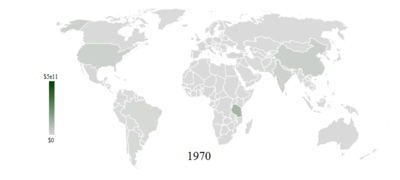
Below is a list of countries by agricultural output in.
| Rank | Country | Output in billions of US$ |
Composition of GDP (%) |
% of Global Agricultural Output |
|---|---|---|---|---|
| — | World | 4,249.237 | 6.1% | 100.0% |
| 1 | 737.113 | 10.1% | 17.3% | |
| — | 316.398 | 1.8% | 7.4% | |
| 2 | 303.382 | 18.1% | 7.1% | |
| 3 | 181.128 | 1.2% | 4.3% | |
| 4 | 144.589 | 5.8% | 3.4% | |
| 5 | 126.006 | 14.9% | 3.0% | |
| 6 | 93.179 | 39.0% | 2.2% | |
| 7 | 82.173 | 1.4% | 1.9% | |
| 8 | 77.717 | 4.2% | 1.9% | |
| 9 | 71.584 | 9.2% | 1.7% | |
| 10 | 59.529 | 4.0% | 1.4% | |
| 11 | 54.034 | 11.2% | 1.3% | |
| 12 | 49.286 | 3.3% | 1.2% | |
| 13 | 47.198 | 1.7% | 1.1% | |
| 14 | 45.971 | 13.3% | 1.1% | |
| 15 | 45.037 | 3.9% | 1.1% | |
| 16 | 44.764 | 10.0% | 1.1% | |
| 17 | 44.008 | 20.9% | 1.0% | |
| 18 | 41.776 | 1.9% | 1.0% | |
| 19 | 33.944 | 14.4% | 0.8% | |
| 20 | 33.442 | 12.0% | 0.8% | |
| - | Remaining Countries | 1,933.377 | 45.5% |
Energy and agriculture
Since the 1940s, agricultural productivity has increased dramatically, due largely to the increased use of energy-intensive mechanization, fertilizers and pesticides. The vast majority of this energy input comes from fossil fuel sources.[129] Between and 1984, the Green Revolution transformed agriculture around the globe, with world grain production increasing by 250%[130][131] as world population doubled. Modern agriculture's heavy reliance on petrochemicals and mechanization has raised concerns that oil shortages could increase costs and reduce agricultural output, causing food shortages.
| Agriculture and food system share (%) of total energy consumption by three industrialized nations |
|||
|---|---|---|---|
| Country | Year | Agriculture (direct & indirect) |
Food system |
| United Kingdom[132] | 2005 | 1.9 | 11 |
| United States[133] | 1996 | 2.1 | 10 |
| United States[134] | 2002 | 2.0 | 14 |
| Sweden[135] | 2000 | 2.5 | 13 |
Modern or industrialized agriculture is dependent on fossil fuels in two fundamental ways: 1) direct consumption on the farm and 2) indirect consumption to manufacture inputs used on the farm. Direct consumption includes the use of lubricants and fuels to operate farm vehicles and machinery; and use of gas, liquid propane, and electricity to power dryers, pumps, lights, heaters, and coolers. American farms directly consumed about 1.2 exajoules (1.1 quadrillion BTU) in or just over 1 percent of the nation's total energy.[136]
Indirect consumption is mainly oil and natural gas used to manufacture fertilizers and pesticides, which accounted for 0.6 exajoules (0.6 quadrillion BTU) in.[136] The energy used to manufacture farm machinery is also a form of indirect agricultural energy consumption, but it is not included in USDA estimates of U.S. agricultural energy use. Together, direct and indirect consumption by U.S. farms accounts for about 2 percent of the nation's energy use. Direct and indirect energy consumption by U.S. farms peaked in 1979, and has gradually declined over the past 30 years.[136]
Food systems encompass not just agricultural production, but also off-farm processing, packaging, transporting, marketing, consumption, and disposal of food and food-related items. Agriculture accounts for less than one-fifth of food system energy use in the United States.[133][134]
In higher incentives for farmers to grow non-food biofuel crops[137] combined with other factors (such as overdevelopment of former farm lands, rising transportation costs, climate change, growing consumer demand in China and India, and population growth)[138] to cause food shortages in Asia, the Middle East, Africa, and Mexico, as well as rising food prices around the globe.[139][140] As of December 37 countries faced food crises, and 20 had imposed some sort of food-price controls. Some of these shortages resulted in food riots and even deadly stampedes.[18][19][20]
The biggest fossil fuel input to agriculture is the use of natural gas as a hydrogen source for the Haber-Bosch fertilizer-creation process.[141] Natural gas is used because it is the cheapest currently available source of hydrogen.[142][143] When oil production becomes so scarce that natural gas is used as a partial stopgap replacement, and hydrogen use in transportation increases, natural gas will become much more expensive. If the Haber Process is unable to be commercialized using renewable energy (such as by electrolysis) or if other sources of hydrogen are not available to replace the Haber Process, in amounts sufficient to supply transportation and agricultural needs, this major source of fertilizer would either become extremely expensive or unavailable. This would either cause food shortages or dramatic rises in food prices.[cn]
Mitigation of effects of petroleum shortages
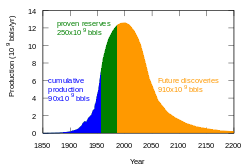
In the event of a petroleum shortage (see peak oil for global concerns), organic agriculture can be more attractive than conventional practices that use petroleum-based pesticides, herbicides, or fertilizers. Some farmers using modern organic-farming methods have reported yields as high as those available from conventional farming.[145][146][147][148] Organic farming may however be more labor-intensive and would require a shift of the workforce from urban to rural areas.[149] The reconditioning of soil to restore nutrients lost during the use of monoculture agriculture techniques also takes time.[145][146][147][148]
It has been suggested that rural communities might obtain fuel from the biochar and synfuel process, which uses agricultural waste to provide charcoal fertilizer, some fuel and food, instead of the normal food vs fuel debate. As the synfuel would be used on-site, the process would be more efficient and might just provide enough fuel for a new organic-agriculture fusion.[150][151]
It has been suggested that some transgenic plants may some day be developed which would allow for maintaining or increasing yields while requiring fewer fossil-fuel-derived inputs than conventional crops.[152] The possibility of success of these programs is questioned by ecologists and economists concerned with unsustainable GMO practices such as terminator seeds.[153][154]
While there has been some research on sustainability using GMO crops, at least one prominent multi-year attempt by Monsanto Company has been unsuccessful, though during the same period traditional breeding techniques yielded a more sustainable variety of the same crop.[155]
Electrical energy efficiency on farms
Policy
Agricultural policy focuses on the goals and methods of agricultural production. At the policy level, common goals of agriculture include:
- Conservation
- Economic stability
- Environmental sustainability
- Food quality: Ensuring that the food supply is of a consistent and known quality.
- Food safety: Ensuring that the food supply is free of contamination.
- Food security: Ensuring that the food supply meets the population's needs.[156][157]
- Poverty reduction
See also
- Agricultural effects of peak oil
- Aeroponics (Indoor growing of food and plants)
- Agricultural economics
- Agricultural engineering
- Agricultural marketing
- Agricultural diversification
- Agroecology
- Agronomy for Sustainable Development
- Animal welfare
- Biopesticides
- Building-integrated agriculture
- Chitosan (natural biocontrol for agricultural and horticultural use)
- Climate change and agriculture
- Contract farming
- Consumption-labour-balance principle
- Crofting
- Doha Development Round
- Ecoagriculture
- Factory farming
- Feed additive
- Food Studies
- Good agricultural practice
- Green Revolution
- Industrial agriculture
- Intensive farming
- Leveraging Agriculture for Improving Nutrition and Health
- No-till farming
- Organic farming
- Permaculture
- Permaforestry
- Rural economics
- Remote sensing[158]
- Smallholder agriculture
- Timeline of agriculture and food technology
- Wildculture
- Vertical farming
- Push–pull technology, pest control strategy for maize and sorghum
Lists
- List of basic agriculture topics
- List of countries by GDP sector composition – breakdown includes agricultural sector information
- List of largest producing countries of agricultural commodities
- List of countries by dietary calorie intake
- List of domesticated animals
- List of subsistence techniques
- List of sustainable agriculture topics
References
- ↑ International Labour Office (1999). Safety and health in agriculture. International Labour Organization. pp. 77–. ISBN 978-92-2-111517-5.
- ↑ "For sustainable architecture, think bug". NewScientist. Archived from the original on 28 February.
- ↑ B. Hölldobler & E.O. Wilson (1990). The Ants. Cambridge MA: Belknap. ISBN 978-0-674-48525-9.
- ↑ "Human Health Issues | Pesticides | US EPA". Epa. 28 June.
- ↑ "EU Scientists Confirm Health Risks of Growth Hormones in Meat". Organicconsumers.
- ↑ Brickates Kennedy, Val (16 October). "Plastics that are green in more ways than one". The Wall Street Journal (New York).
- ↑ "Growing Plants for Pharmaceutical Production vs. for Food and Feed Crops". bio. Washington DC: Biotechnology Industry Organization.[dead link]
- ↑ "Reengaging in Agricultural Water Management: Challenges and Options". The World Bank. pp. 4–5.
- ↑ "Key Indicators of the Labour Market Programme". International Labour Organization. 7 September.
- ↑ Latin Word Lookup
- ↑ Latin Word Lookup
- ↑ Barrionuevo, Alexei; Bradsher, Keith (8 December). "Sometimes a Bumper Crop Is Too Much of a Good Thing". The New York Times.
- ↑ Schneider, Keith (8 September). "Science Academy Recommends Resumption of Natural Farming". The New York Times.
- ↑ The World Bank (1995), Overcoming Agricultural Water Pollution in the European Union[dead link].
- ↑ European Commission, CAP Reform.
- ↑ "At Tyson and Kraft, Grain Costs Limit Profit". The New York Times. Bloomberg. 6 September.
- ↑ McMullen, Alia (7 January). "Forget oil, the new global crisis is food". Financial Post (Toronto).
- ↑ 18.0 18.1 Watts, Jonathan (4 December). "Riots and hunger feared as demand for grain sends food costs soaring", The Guardian (London).
- ↑ 19.0 19.1 Mortished, Carl (7 March)."Already we have riots, hoarding, panic: the sign of things to come?", The Times (London).
- ↑ 20.0 20.1 Borger, Julian (26 February). "Feed the world? We are fighting a losing battle, UN admits", The Guardian (London).
- ↑ McKie, Robin; Rice, Xan (22 April). "Millions face famine as crop disease rages", The Observer' (London).
- ↑ Mackenzie, Debora (3 April). "Billions at risk from wheat super-blight". New Scientist (London) (2598): 6–7.
- ↑ Leonard, K.J. Black stem rust biology and threat to wheat growers, USDA ARS
- ↑ Sample, Ian (31 August). "Global food crisis looms as climate change and population growth strip fertile land", The Guardian (London).
- ↑ "Africa may be able to feed only 25% of its population by", mongabay, 14 December.
- ↑ Luc-Normand Tellier. "Urban world history: an economic and geographical perspective". PUQ. p.26. ISBN 2-7605-1588-5
- ↑ Douglas John McConnell. The Forest Farms of Kandy: And Other Gardens of Complete Design. p. 1. ISBN 9780754609582.
- ↑ Douglas John McConnell (1992). The forest-garden farms of Kandy, Sri Lanka. p. 1. ISBN 9789251028988.
- ↑ In particular, the history of maize cultivation in southern Mexico dates back 9000 years. New York Times, accessdate=2010-5-4
- ↑ "Farming older than thought", University of Calgary, 19 February.
- ↑ S. Johannessen and C. A. Hastorf (eds.) Corn and Culture in the Prehistoric New World, Westview Press, Boulder, Colorado.
- ↑ Heiser, Carl B., Jr. (1992) On Possible Sources of the Tobacco of Prehistoric Eastern North America. Current Anthropology 33:54–56.
- ↑ Prehistoric Food Production in North America, edited by Richard I. Ford. Museum of Anthropology, University of Michigan, Anthropological Papers 75.
- ↑ Adair, Mary J. (1988) Prehistoric Agriculture in the Central Plains. Publications in Anthropology 16. University of Kansas, Lawrence.
- ↑ Paul E. Minnis (editor) People and Plants in Ancient Eastern North America. Smithsonian Institution Press, Washington, D.C.
- ↑ Plough used in the South-English South Street, in 3500
- ↑ The seventy great inventions of the ancient world by Brian M.Fagan
- ↑ Campbell, Bruce M. S.; M. Overton (1993). "A New Perspective on Medieval and Early Modern Agriculture: Six Centuries of Norfolk Farming, c.1250-c.1850". Past and Present 141: 38–105. doi:10.1093/past/141.1.38.
- ↑ Campbell, Bruce M.S.. English Seigniorial Agriculture, 1250–1450. Cambridge: Cambridge University Press. ISBN 0-521-30412-1, 9780521304122.
- ↑ Stone, David. Decision-Making in Medieval Agriculture. Oxford: Oxford University Press. ISBN 0-19-924776-5, 9780199247769.
- ↑ John Langdon. Robert E. Bjork. ed. The Oxford Dictionary of the Middle Ages. Oxford, England: Oxford University Press. p. 1841. ISBN 978-0-19-866262-4.
- ↑ "The Impact of the Potato", History Magazine.
- ↑ Super-Sized Cassava Plants May Help Fight Hunger In Africa. The Ohio State University
- ↑ "Maize Streak Virus-Resistant Transgenic Maize: an African solution to an African Problem", scitizen, 7 August.
- ↑ Noel Kingsbury Hybrid. The History and Science of Plant Breeding, University of Chicago Press, Chicago.
- ↑ 46.0 46.1 46.2 46.3 Matson et al. (1997). Agricultural Intensification and Ecosystem Properties. Science.
- ↑ USDA NAL Special Collections. South China explorations: typescript, 25 July – 21 September
- ↑ USDA NAL Special Collections. Dorsett-Morse Oriental Agricultural Exploration Expedition Collection
- ↑ USDA ERS. Agricultural Productivity in the United States
- ↑ "The Food Bubble Economy". The Institute of Science in Society.
- ↑ Brown, Lester R.. "Global Water Shortages May Lead to Food Shortages-Aquifer Depletion". Archived from the original on 24 July.
- ↑ "India grows a grain crisis", Asia Times (Hong Kong). 21 July.
- ↑ U.N. Food and Agriculture Organization. Rome. "Analysis of farming systems". Retrieved 7 December.
- ↑ 55.0 55.1 Acquaah, G.. Agricultural Production Systems. pp. 283–317 in "Principles of Crop Production, Theories, Techniques and Technology". Prentice Hall, Upper Saddle River, NJ.
- ↑ 56.0 56.1 56.2 56.3 56.4 56.5 56.6 56.7 Chrispeels, M.J.; Sadava, D.E. 1994. "Farming Systems: Development, Productivity, and Sustainability". pp. 25–57 in Plants, Genes, and Agriculture. Jones and Bartlett, Boston, MA.
- ↑ Gold, M.V. 1999. USDA National Agriculture Library. Beltsville, MD. "Sustainable Agriculture: Definitions and Terms". Retrieved 7 December.
- ↑ Earles, R.; Williams, P.. ATTRA National Sustainable Agriculture Information Service. Fayetville, AR. "Sustainable Agriculture:An Introduction". Retrieved 7 December.
- ↑ 59.0 59.1 "Food and Agriculture Organization of the United Nations (FAOSTAT)". Archived from the original on 11 October.
- ↑ Sere, C.; Steinfeld, H.; Groeneweld, J. 1995. "Description of Systems in World Livestock Systems – Current status issues and trends". U.N. Food and Agriculture Organization. Rome. Retrieved 7 December.
- ↑ FAO Database,
- ↑ Brady, N.C. and R.R. Weil.. Elements of the Nature and Properties of Soils. Pearson Prentice Hall, Upper Saddle River, NJ.
- ↑ Acquaah, G.. "Land Preparation and Farm Energy" pp.318–338 in Principles of Crop Production, Theories, Techniques and Technology. Prentice Hall, Upper Saddle River, NJ.
- ↑ Acquaah, G.. "Pesticide Use in U.S. Crop Production" pp.240–282 in Principles of Crop Production, Theories, Techniques and Technology. Prentice Hall, Upper Saddle River, NJ.
- ↑ Acquaah, G.. "Soil and Land" pp.165–210 in Principles of Crop Production, Theories, Techniques and Technology. Prentice Hall, Upper Saddle River, NJ.
- ↑ Chrispeels, M.J.; Sadava, D.E. 1994. "Nutrition from the Soil" pp.187–218 in Plants, Genes, and Agriculture. Jones and Bartlett, Boston, MA.
- ↑ Brady, N.C.; Weil, R.R.. "Practical Nutrient Management" pp.472–515 in Elements of the Nature and Properties of Soils. Pearson Prentice Hall, Upper Saddle River, NJ.
- ↑ Acquaah, G.. "Plants and Soil Water" pp.211–239 in Principles of Crop Production, Theories, Techniques and Technology. Prentice Hall, Upper Saddle River, NJ.
- ↑ Pimentel, D.; Berger, D.; Filberto, D.; Newton, M.; et al.. "Water Resources: Agricultural and Environmental Issues". Bioscience 54:909–918.
- ↑ Sexton,R.J.. "Industrialization and Consolidation in the US Food Sector: Implications for Competition and Welfare". American Journal of Agricultural Economics 82 (5): 1087–1104. doi:10.1111/0002-9092.00106.
- ↑ History of Plant Breeding. Retrieved 8 December.
- ↑ Berg, Paul; Singer, Maxine (15 August). George Beadle: An Uncommon Farmer. The Emergence of Genetics in the 20th century. Cold Springs Harbor Laboratory Press. ISBN 978-0-87969-688-7.
- ↑ Ruttan, Vernon W. (December 1999). "Biotechnology and Agriculture: A Skeptical Perspective" (–Scholar search). AgBioForum 2 (1): 54–60. Archived from the original on 24 October.
- ↑ Cassman, K. (5 December). "Ecological intensification of cereal production systems: The Challenge of increasing crop yield potential and precision agriculture". Proceedings of a National Academy of Sciences Colloquium, Irvine, California (University of Nebraska). Archived from the original on 24 October.
- ↑ Conversion note: 1 bushel of wheat = 60 pounds (lb) ≈ 27.215 kg. 1 bushel of maize = 56 pounds ≈ 25.401 kg
- ↑ Adoption of Genetically Engineered Crops in the US: Extent of Adoption. Retrieved 8 December.
- ↑ 78.0 78.1 . Retrieved 8 December.
- ↑ Report Raises Alarm over 'Super-weeds'. Retrieved 9 December.
- ↑ Ozturk, et al., "Glyphosate inhibition of ferric reductase activity in iron deficient sunflower roots", New Phtologist, 177:899–906.
- ↑ [1]|Genetically Engineered Crops in the US: Extent of Adoption]. Retrieved 8 December.
- ↑ Kimbrell, A. Faltal Harvest: The Tragedy of Industrial Agriculture, Island Press, Washington.
- ↑ Conway, G.. Genetically modified crops: risks and promise. 4(1): 2. Conservation Ecology.
- ↑ . R. Pillarisetti and Kylie Radel (June). Economic and Environmental Issues in International Trade and Production of Genetically Modified Foods and Crops and the WTO. 19. Journal of Economic Integration. pp. 332–352.[dead link]
- ↑ UN biodiversity meet fails to address key outstanding issues, Third World Network. Retrieved 9 December.
- ↑ Who Owns Nature?. Retrieved 9 December.
- ↑ 87.0 87.1 Shiva, Vandana. Biopiracy, South End Press, Cambridge, MA, 1997.
- ↑ Nabhan, Gary Paul. Enduring Seeds, The University of Arizona Press, Tucson, 1989.
- ↑ Shiva, Vanadana. Stolen Harvest: The Hijacking of the Global Food Supply South End Press, Cambrdge, MA, pp. 90–93.
- ↑ "USDA/ERS Data – Agricultural Productivity in the United States". USDA Economic Research Service. 17 August [2].
- ↑ Ruben N. Lubowski, Marlow Vesterby, Shawn Bucholtz, Alba Baez and Michael J. Roberts. Major Uses of Land in The United States. USDA Economic Research Service.
- ↑ NIOSH Workplace Safety & Health Topic: Agricultural Injuries
- ↑ 93.0 93.1 NIOSH Workplace Safety & Health Topic: Agriculture
- ↑
- ↑ Guidelines for Children's Agricultural Tasks Demonstrate Effectiveness
- ↑ Boelee, E. (Ed) Ecosystems for water and food security, IWMI, UNEP
- ↑ Molden, D., Opinion: The Water Deficit, The Scientist, 23 August
- ↑ Safefood Consulting, Inc., Benefits of Crop Protection Technologies on Canadian Food Production, Nutrition, Economy and the Environment. Guelph, ON:.
- ↑ Trewavas, Anthony. "A critical assessment of organic farming-and-food assertions with particular respect to the UK and the potential environmental benefits of no-till agriculture". Crop Protection: 757–781.
- ↑ Fernandez-Cornejo, J. "Issues in the Economics of Pesticide Use in Agriculture: A Review of the Empirical Evidence". Review of Agricultural Economics 1998: 462–488.
- ↑ Shiva, Vandana. Earth Democracy: Justice, Sustainability, and Peace, South End Press, Cambridge, MA.
- ↑ Jowit, Juliette (22 September). "Corporate Lobbying Is Blocking Food Reforms, Senior UN Official Warns: Farming Summit Told of Delaying Tactics by Large Agribusiness and Food Producers on Decisions that Would Improve Human Health and the Environment". The Guardian (London)., The Guardian (UK), Sept. 22
- ↑ Priority products and materials: assessing the environmental impacts of consumption and production International Resource Panel, United Nations Environment Programme,
- ↑ Molden, D. (Ed). Water for food, Water for life: A Comprehensive Assessment of Water Management in Agriculture Earthscan/IWMI, p.11
- ↑ Chartres, C. and Varma, S. Out of water. From Abundance to Scarcity and How to Solve the World’s Water Problems FT Press (USA),
- ↑ "Livestock a major threat to environment". UN Food and Agriculture Organization. November 29. Archived from the original on 28 March.
- ↑ Vitousek, P.M.; Mooney, H.A.; Lubchenco, J.; Melillo, J.M. 1997. "Human Domination of Earth's Ecosystems". Science 277:494–499.
- ↑ Bai, Z.G., D.L. Dent, L. Olsson, and M.E. Schaepman.. Global assessment of land degradation and improvement 1:identification by remote sensing. Report, FAO/ISRIC – Rome/Wageningen. Retrieved on 5 December from "Land degradation on the rise"[dead link]
- ↑ Carpenter, S.R., N.F. Caraco, D.L. Correll, R.W. Howarth, A.N. Sharpley, and V.H. Smith. 1998. "Nonpoint Pollution of Surface Waters with Phosphorus and Nitrogen". Ecological Applications 8:559–568.
- ↑ Pimentel, D. T.W. Culliney, and T. Bashore. 1996. "Public health risks associated with pesticides and natural toxins in foods in Radcliffe's IPM World Textbook". Retrieved 7 December.
- ↑ WHO. 1992. Our planet, our health: Report of the WHU commission on health and environment. Geneva: World Health Organization.
- ↑ 115.0 115.1 Chrispeels, M.J. and D.E. Sadava. 1994. "Strategies for Pest Control" pp.355–383 in Plants, Genes, and Agriculture. Jones and Bartlett, Boston, MA.
- ↑ Avery, D.T.. Saving the Planet with Pesticides and Plastic: The Environmental Triumph of High-Yield Farming. Hudson Institute, Indianapolis, IN.
- ↑ Center for Global Food Issues. Churchville, VA. "Center for Global Food Issues.". Retrieved 7 December.
- ↑ Lappe, F.M., J. Collins, and P. Rosset. 1998. "Myth 4: Food vs. Our Environment" pp. 42–57 in World Hunger, Twelve Myths, Grove Press, New York.
- ↑ Fraser, E.: “Crop yield and climate change”, Retrieved on 14 September.
- ↑ 120.0 120.1 Brady, N.C. and R.R. Weil.. "Soil Organic Matter" pp.353–385 in Elements of the Nature and Properties of Soils. Pearson Prentice Hall, Upper Saddle River, NJ.
- ↑ Brady, N.C. and R.R. Weil.. "Nitrogen and Sulfur Economy of Soils" pp.386–421 in Elements of the Nature and Properties of Soils. Pearson Prentice Hall, Upper Saddle River, NJ.
- ↑ Baxter, Joan (19 May). "Cotton subsidies squeeze Mali". BBC News (London).
- ↑ "socio en su producción" (in Spanish). megaagro.uy.
- ↑ "mercado de faena" (in Spanish). megaagro.uy.
- ↑ "China: Feeding a Huge Population". Kansas-Asia (ONG). Archived from the original on 21 February. "average farming household in China now cultivates about one hectare"
- ↑ "Paraguay farmland real estate". Peer Voss. Archived from the original on 19 February.
- ↑ "Brazil frontier farmland". AgBrazil. Archived from the original on 27 February.
- ↑ "World oil supplies are set to run out faster than expected, warn scientists". The Independent. 14 June.
- ↑ The limits of a Green Revolution?
- ↑ The Real Green Revolution[dead link]
- ↑ Rebecca White. "Carbon governance from a systems perspective: an investigation of food production and consumption in the UK," Oxford University Center for the Environment
- ↑ 133.0 133.1 Martin Heller and Gregory Keoleian. "Life Cycle-Based Sustainability Indicators for Assessment of the U.S. Food System," University of Michigan Center for Sustainable Food Systems.
- ↑ Christine Wallgren & Mattias Hojer. "Eating energy—Identifying possibilities for reduced energy use in the future." Energy Policy 37: 5803–5813. doi:10.1016/j.enpol.2009.08.046
- ↑ 136.0 136.1 136.2 Randy Schnepf. "Energy use in Agriculture: Background and Issues," CRS Report for Congress.
- ↑ Smith, Kate; Edwards, Rob (8 March)."2008: The year of global food crisis", The Herald (Glasgow).
- ↑ "The global grain bubble", The Christian Science Monitor (Boston), 18 January.
- ↑ "The cost of food: Facts and figures", BBC News Online (London), 16 October.
- ↑ Walt, Vivienne (27 February)."The World's Growing Food-Price Crisis", Time (New York).
- ↑ Raw Material Reserves – International Fertilizer Industry Association[dead link]
- ↑ Integrated Crop Management-Iowa State University 29 January [3]
- ↑ "The Hydrogen Economy", Physics Today, December.
- ↑ "World oil supplies are set to run out faster than expected, warn scientists". The Independent. 14 June.
- ↑ 145.0 145.1 Realities of organic farming
- ↑ 146.0 146.1
- ↑ 147.0 147.1 Organic Farming can Feed The World![dead link]
- ↑ 148.0 148.1 Organic Farms Use Less Energy And Water
- ↑ Strochlic, R.; Sierra, L.. [dead link]. California Institute for Rural Studies.
- ↑ "Carbon cycle management with increased photo-synthesis and long-term sinks", Royal Society of New Zealand.[dead link]
- ↑ Greene, Nathanael (December). [dead link].
- ↑ Srinivas et al (June). Reviewing The Methodologies For Sustainable Living. 7. The Electronic Journal of Environmental, Agricultural and Food Chemistry. pp. 2993–3014.
- ↑ Conway, G.. Genetically modified crops: risks and promise. 4(1): 2. Conservation Ecology.
- ↑ Pillarisetti, R.; Radel, Kylie (June). Economic and Environmental Issues in International Trade and Production of Genetically Modified Foods and Crops and the WTO. 19. Journal of Economic Integration. pp. 332–352.[dead link]
- ↑ "Monsanto failure". New Scientist (London) 181 (2433). 7 February.
- ↑ Record rise in wheat price prompts UN official to warn that surge in food prices may trigger social unrest in developing countries
- ↑ Trumbull, Mark (24 July). "Rising food prices curb aid to global poor", The Christian Science Monitor (Boston).
- ↑ Remote sensing becoming an increasingly important technique for agriculture
Bibliography
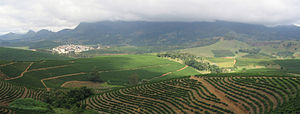
- Alvarez, Robert A.. "The March of Empire: Mangos, Avocados, and the Politics of Transfer". Gastronomica, Vol. 7, No. 3, 28–33. Retrieved on 12 November.
- Bolens, L. (1997). "Agriculture" in Selin, Helaine (ed.), Encyclopedia of the history of Science, technology, and Medicine in Non Western Cultures. Kluwer Academic Publishers, Dordrecht/Boston/London, pp. 20–22.
- Collinson, M. (ed.) A History of Farming Systems Research. CABI Publishing. ISBN 978-0-85199-405-5
- Crosby, Alfred W.: The Columbian Exchange: Biological and Cultural Consequences of 1492. Praeger Publishers, (30th Anniversary Edition). ISBN 978-0-275-98073-3
- Davis, Donald R.; Riordan, Hugh D.. "Changes in USDA Food Composition Data for 43 Garden Crops, to 1999". Journal of the American College of Nutrition, Vol. 23, No. 6, 669–682.
- Duplessis, Robert. S. (1997). "Transitions to Capitalism in Early Modern Europe." Cambridge University Press.
- Friedland, William H.; Barton, Amy (1975). "Destalking the Wily Tomato: A Case Study of Social Consequences in California Agricultural Research". Univ. California at Sta. Cruz, Research Monograph 15.
- Mazoyer, Marcel; Roudart, Laurence. A history of world agriculture : from the Neolithic Age to the current crisis. Monthly Review Press, New York. ISBN 978-1-58367-121-4
- Saltini A. Storia delle scienze agrarie, 4 vols, Bologna 1984–89, ISBN 978-88-206-2412-5, ISBN 978-88-206-2413-2, ISBN 978-88-206-2414-9, ISBN 978-88-206-2414-9
- Watson, A.M. (1974). "The Arab agricultural revolution and its diffusion", in The Journal of Economic History, 34.
- Watson, A.M. (1983). Agricultural Innovation in the Early Islamic World, Cambridge University Press.
- Wells, Spencer. The Journey of Man: A Genetic Odyssey. Princeton University Press. ISBN 978-0-691-11532-0
- Wickens, G.M. (1976). "What the West borrowed from the Middle East", in Savory, R.M. (ed.) Introduction to Islamic Civilization. Cambridge University Press.
External links
| Wikimedia Commons has media related to: Agriculture |
| Wikiquote has a collection of quotations related to: Agriculture |
| Look up agriculture in Wiktionary, the free dictionary. |
| Wikiversity has learning materials about Agriculture |
- Agriculture from UCB Libraries GovPubs
- Agriculture and Rural development from the World Bank
- The World Bank on Agricultural water management
- Gender in agriculture and rural development (FAO)
- Index to the Manuscript Collections Special Collections, National Agricultural Library
- The American Society of Agronomy (ASA)
- International Federation of Agricultural Producers (IFAP)
- NIOSH Agriculture Page – safety laws, tips, and guidelines
- National Ag Safety Database
- North American Guidelines for Children's Agricultural Tasks
- U.S. House Committee on Agriculture – Glossary of agricultural terms, programs and laws
- UKAgriculture – Advance the education of the public in all aspects of agriculture, the countryside and the rural economy
- Collection of Agriculture Dictionaries
- Peace Palace Library – Research Guide
Farmer Power: The Continuing Confrontation between Subsistence Farmers and Development Bureaucrats by Tony Waters at Ethnography [4]
- Agricultural Land Africa
- Agricultural Land Europe
| This page uses content from Wikipedia. The original article was at Agriculture. The list of authors can be seen in the page history. The text of this Wikinfo article is available under the GNU Free Documentation License and the Creative Commons Attribution-Share Alike 3.0 license. |
